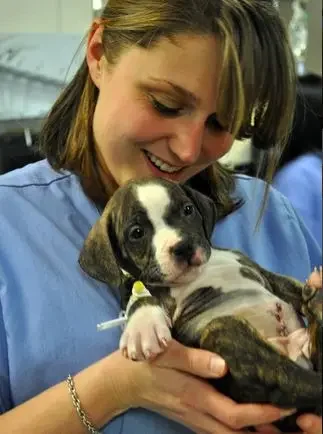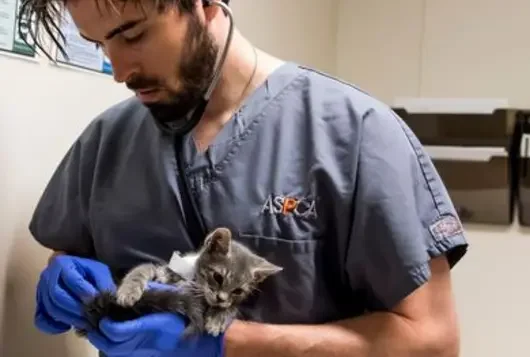Pointers for Pediatric Spay/Neuter

Here are primary considerations you should keep in mind when performing a pediatric surgical procedure.
Pre-Surgical and Anesthetic Considerations
The handling of pediatric patients before surgery should be minimized to prevent excitement before sedation for surgery. For example, staff should be urged to resist the temptation to play with the puppies or kittens.
Excited animals will resist being restrained, and they become more difficult to sedate. Littermates should be housed together to reduce their stress.
Intramuscular or subcutaneous injections for initial sedation or pre-medication are recommended as less restraint is needed.
Pediatric patients are at greater risk of hypoglycemia. They should not be fasted for more than 3-4 hours before the procedure, (some even recommend feeding a small meal to patients under 16 weeks of age 2-4 hours before the procedure), and they should fed immediately upon recovery from anesthesia.
Hypothermia can also be a problem for these patients because they have a lower percentage of body fat and a decreased ability to shiver to warm themselves.
Contact with cold surfaces should be reduced. A small area of hair at the surgical site should be clipped and a warm surgical scrub used. The use of alcohol should be avoided or minimized because of its cooling effects on the skin. Supplemental heating sources should be used as needed and carefully monitored, such as circulating warm water heating pads or carefully monitored warm-water bottles. (Avoid placing them directly on the skin, and remove them immediately when they become cool.)
There are many different protocols in the literature for pediatric anesthesia. The most successful protocols are usually already in use by the veterinarian with adjustments for the weight difference. Current recommendations include the use of multimodal analgesia, and careful measurement and administration of the drugs.
Good monitoring of the patient for depth of anesthesia and safety is no different from the protocols used for any other patient. These include observing the heart and respiratory rates, pulse quality, rate, and rhythm, jaw tone, etc.
Surgical Considerations
Videos and description of the surgery are readily available so the actual procedures will not be described here. In general, structures are much smaller and exposure can be decreased. Tissues must be handled gently and close attention paid to hemostasis, but this is true in any surgical procedure. Actually, in most cases, bleeding in these animals is minimal. Usually only single ligatures are indicated, compared to the adult patient where double ligation is often necessary. Pediatric animals can have a significant amount of clear abdominal fluid, but this is normal and no cause for alarm.
The animals should be tattooed in the inguinal region, on the ventral abdomen or have tattoo ink applied to the incision to identify them as having already been neutered. Tattooing is as important for males as it is for females, as it might spare male animals from exploratory surgery if it was assumed the animal had bilaterally retained testicles.
Post-Surgical Considerations
Puppies and kittens should be kept warm in the post-operative period. Heating lamps can be used to prevent hypothermia as long as the patient is closely monitored while under the lamp. If there are problems with the recovery, their temperature and blood glucose should be checked.
A small meal should be offered within an hour after anesthetic recovery to minimize the chance of developing hypoglycemia. If there are signs of hypoglycemia, treat quickly and accordingly. Many practitioners recommend routinely applying a small amount of Nutrical on the gums of the recovering pediatric patient.
In performing a risk-benefit analysis of the long term outcomes of pediatric neutering, it should be reiterated that the incidence of many of the serious side effects associated with pediatric neutering, such as hemangiosarcoma, is low compared to many other common diseases that can be prevented by neutering (such as mammary neoplasia, pyometra, and prostatic hyperplasia, and that most of the studies). It should also be noted that many studies conclude by stating that further studies are warranted.
As with any surgical procedure, there are advantages and disadvantages to any spay/neuter procedure, regardless of the age of the animal. However, the risk of complications is less with pediatric spay /neuter. Veterinarians should discuss both the benefits and risks of pediatric surgery with the client, evaluating each patient on an individual basis. Pediatric neutering is important for shelters because with these procedures, almost every animal can be neutered prior to adoption, which helps prevent the birth of unwanted litters that often end up at the shelter.
Private practitioners should also consider performing pediatric spay/neuter because of the many medical advantages and to help reduce the euthanasia of unwanted animals.
More Resources
Definition and History of Pediatric S/N
Dealing With Concerns About Pediatric S/N
We have lots more on this subject:

